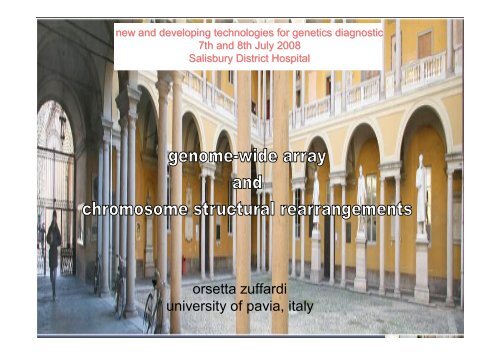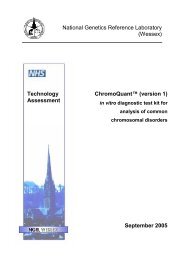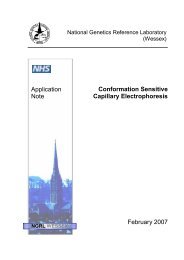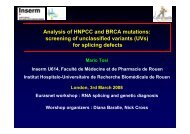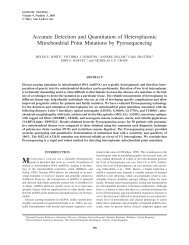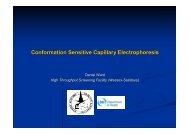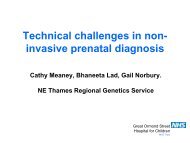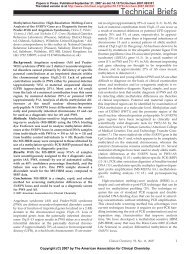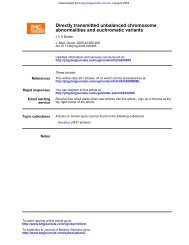New arrays for structural abnormality
New arrays for structural abnormality
New arrays for structural abnormality
You also want an ePaper? Increase the reach of your titles
YUMPU automatically turns print PDFs into web optimized ePapers that Google loves.
new and developing technologies <strong>for</strong> genetics diagnostic7th and 8th July 2008Salisbury District Hospitalorsetta zuffardiuniversity of pavia, italy
Chrom 5qbreakpoint161.590161.964About 20 Mb duplication
distal deletion at Xpdemonstrated by FISH with subtelomeric probesthe 244k Agilent plat<strong>for</strong>mdoes not have oligomersin PAR1;last oligomer at 2,693 MbX duplicationproximalbreakpoint:4.8254.933
46,X,der(X)t(X;5)(p22.3;q33)de novo46,der(X)t(inv dup delX;5)(p22.3;q33)de novo
46,XX,der(8)t(8;17)(p22.3;p12)de novo
Dup(17)(p13.2pter)Breakpoint: 4,1394,167 Mb.
8 Del(8)(23.1pter)Breakpoint:6,9017,290 MbDup(8)(p21.2p23.1)Proximal breakpoint:24,54824,829 MbDistal breakpoint:12,28512,627 Mb
46,XX,der(8)t(8;17)(p22.3;p12)de novo46,XX,der(8)t(inv dup del8;17)(p22.3;p12)de novo
Stabilization of a terminal inversion duplication of 8p by telomere capture from 18qD.R. Kostiner, 2002
two cases of inv dup del(8p)stabilized by the distal regionof another chromosome
The inv dup del(8p) syndrome
The inv dup del(8p) is not the primary productof the abnormal meiotic recombinationFloridia et al 1996
the dicentric chromosome derives fromnonallelic homologous recombination at the maternal meiosison the background of a cryptic paracentric inversionGiglio et al, 2001Metaphase from a mothertransmitting “de novo” inv dup del(8p)
Theoretical recombinant productsfrom classical crossover in paracentric inversion
Does the reciprocal productof the dicentric chromosome exist??FISH with chrom. 8subtelomeric specific probesWarburton, 2004
The inv dup del (8p)derives fromthe breakage ofa dicentricchromosomeThe acentricchromosomecan acquirea neocentromerethus being rescued
another demonstration thatthe dicentric originates at MIand it is not postzygoticThe duplication regionof the inv dup del(8p)contains two maternaland one paternal alleleMarker Position Alleles StatusD8S504 1004 1 DD8S264 2117 1 DD8S201 3027D8S1824 3540D8S262 3664D8S518 4475D8S277 6504D8S1819 6737 1 DMSAT3 7750ORREPDD8S503 9270 1, 2 ND8S1721 10178 1, 2 ND8S520 10593 1, 2 ND8S550 10990D8S265 11317ORREPPD8S552 12752 1, 2, 3 DupD8S511 14690 1, 2, 3 DupD8S549 15660D8S254 16618 1, 2, 3 DupD8S261 17836 1, 2, 3 DupD8S258 20377 1, 2, 3 DupD8S282 21425 1, 2, 3 DupD8S1734 22817 1, 2, 3 DupD8S1771 25463D8S1809 28213 1, 2, 3 DupD8S278 32606 1, 2 ND8S513 33727D8S1750 35470 1, 2 ND8S1821 38369 1, 2 ND8S255 39902 1, 2 ND8S268 41264 1, 2 ND8S1115 42554D8S531 49074 1, 2 N
The rearrangement occurs at MI through NAHR;the dicentric chromosome can beeither immediately broken at MIIorbe inherited as such in the zygotesome inv dup del (8p) cases in mosaic withdifferent derivatives of the original dicentric:üpresence of the dicentric in the zygote;üthe occurrence of different cell linesin the early embryogenesis;üthe most viable one(s) will be detected at birth
cultured chorion villi:inv dup del(8p)direct chorion villi: del(8)(p11.1)Pramparo et al, EJHG,2004
Soler et al, 2003; both cell lines found in direct CVS
A third cell line found in the cultured CV showed the transpositionof satellites to the short arm of the inv dup del(8p): telomere capturePramparo et al, EJHG, 2004
Translocations and telomerecapture……… a brokenchromosome that is repairedby invading and replicatingsequences from anotherchromosome end.This results ina nonreciprocal translocationFrom L. Shaffer, 2004
the zygote may receive thedicentric chromosomethat undergoes differentbreakages in the different cellsleading to different cell linesthe absence of telomerase during early embryogenesismay cause telomere capture
Telomerase activity is low or absent in cleavage stage embryosand then high again in blastocystHow early embryos reset telomere length remains poorly understoodWe suggest that telomeres lengthen during the early cleavage cyclesfollowing fertilization through a recombinationbased mechanismTelomere lengthening early in development recombinationbasedmechanismL. Liu, Nature Cell Biology December 2007
Abuelo et al, 2000AJMG AHMGAJMG46,X,der(X)t(X;5)(p22.3;q33)de novoXp deletion demonstrated through FISH with subtelomeric probes
analphoid XpX5dic(Xp)t(inv dup delXp;5q)and not t(Xp;5q)
how many times in de novo unbalanced translocationsone of the two derivative chromosomes arisespostzygotically froman inv dup delstabilized through telomere capture???are all de novo unbalaced translocations<strong>for</strong>med through this mechanism?????
Terminally deleted chromosome can also resultpost-zygoticallyfrom the breakage of the dicentric chromosomeAlso this de novo unbalancedtranslocation may derivefrom a dicentric chromosomebreakagedupdeldelt(dupdel;?) t(del:?)
How can we discriminatebetween a pre- ora post-zygotic event???t(dupdel;?) t(del:?)classical translocation
If de novo unbalanced translocations werepostzygotic events,there is a 50% probability that the deletion ariseson the paternal chromosome and the duplicationon the maternal one or viceversaPostzygotic(pat. deletion;mat. duplication)either paternalgametogenesis orpostzygotic(pat. deletion;pat. duplication)
Molecular and cytogenetic analysis of the spreadingof X inactivation in a girl with microcephaly, milddysmorphic features and t(X;5)(q22.1;q31.1Giorda et al, 2008 EJHGtranscriptional activity of a number of chromosome 5 lociby RTPCR analysisde novoXq deletion5q duplication
Xq deletion occurred on the mat chrom. X5q duplication occurred on the pat chrom. 5:a postzygotic rearrangementMolecular typing per<strong>for</strong>med on proband and parents +a somatic cell hybrids containing the normal X +a clone containing both the normal X and the der(X)was the der(X) <strong>for</strong>med bythe breakage of a dicentric chromosome X???Molecular typing per<strong>for</strong>med on proband and parents +two somatic cell hybrids containing the pat and the mat chromosome 5*: duplicated alleles
postzygotic <strong>for</strong>mation of translocations is considereda rare event in absence of mosaicismthe parental origin of nonmosaic unbalanced translocationsis usually stated by testing microsatellites <strong>for</strong> the deletion regionmaking impossible to detect any disagreementwith the parental origin of the duplicated chromosomepostzygotic translocations may be more frequentthan ever suspected
Mechanisms of ring <strong>for</strong>mation
Array-CGH prophile (100 kb resolution) of a r(13)terminal deletion: 10 Mbs;contiguous duplication: 21 Mbsterminal deletion of 10Mb; duplication of 21Mb
FISH analysis:Inv dup del r(13)The duplication region is inverted
Array-CGH prophile (100 kb resolution) of a r(15)r(15)duplication of2Mbterminal deletionof 5MbThe duplicationregion is inverted
dup del ringsImportant in genotype/phenotype correlations!!!Frequency??7/31 ringsRossi et al, JMG 2008
Ring chromosomes may have the same origin ofinv dup del rearrangementsTelomerehealing,in absenceoftelomerase,might beobtainedthroughcircularizationinstead than throughtelomere capture
Some “normal”ring chromosomes can also resultpost-zygoticallyfrom the breakage of the dicentric chromosomedicentricbreakage dupdel deldupdel ringdel ring
Dicentric chromosomes, both from NAHR and NHEJ,may generate differentpost-zygoticunbalanced rearrangementsInv dup delsDels??Acentric supernumerary marker chromosomesUnbalanced translocations (Inv dup del; second chromosome)Unbalanced translocations (del; second chromosome)??Rings (Inv dup del)Rings (del)??
a dicentric ghost behind several constitutional chromosome rearrangements???
How can we discriminatebetween a pre- ora post-zygotic event???t(inv dup del;portion of A or sex chrom)classical translocation
post zygotic translocations due to telomere captureof a broken dicentric chromosomeready <strong>for</strong> telomere capture
To prove that de novo unbalanced translocations are postzygotic:Test a number of de novo unbalanced translocations<strong>for</strong> the parental origin of both the deleted and theduplicated portionIf postzygotic origin: in 50% of the cases deletion paternaland duplication maternal or viceversaPer<strong>for</strong>m genomewide array to see if one of the derivativeis an invdupdel
a translocation with a derivative from one parentand the second derivative from the other one demonstratesa postzygotic event and is in favor of the hypothesis of a zygotein which one of the derivative chromosome was originallya dicentric chromosome


